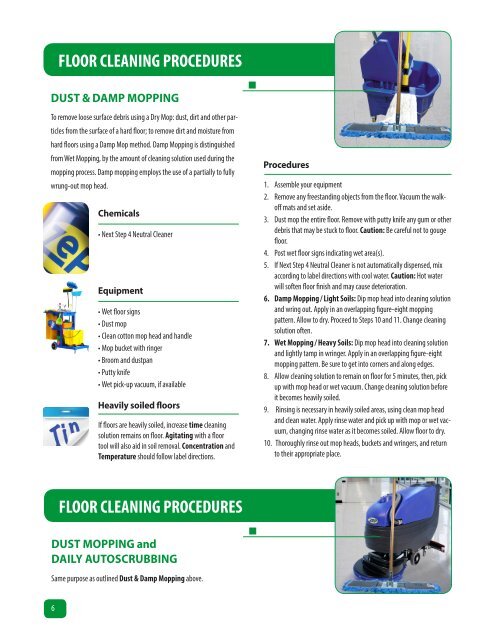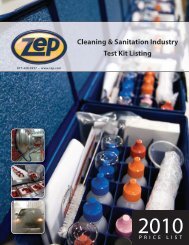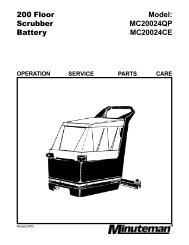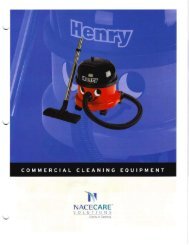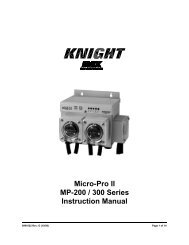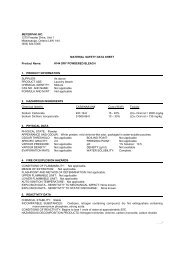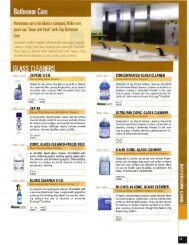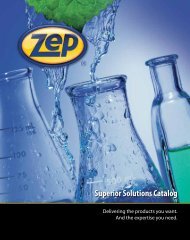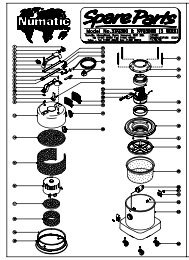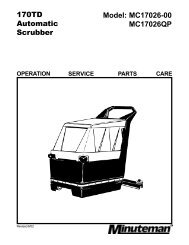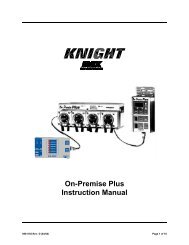How to/Next Step Floor Care Procedures Manual .pdf
How to/Next Step Floor Care Procedures Manual .pdf
How to/Next Step Floor Care Procedures Manual .pdf
You also want an ePaper? Increase the reach of your titles
YUMPU automatically turns print PDFs into web optimized ePapers that Google loves.
FLOOR CLEANING PROCEDURES<br />
DUST & DAMP MOPPING<br />
To remove loose surface debris using a Dry Mop: dust, dirt and other particles<br />
from the surface of a hard floor; <strong>to</strong> remove dirt and moisture from<br />
hard floors using a Damp Mop method. Damp Mopping is distinguished<br />
from Wet Mopping, by the amount of cleaning solution used during the<br />
mopping process. Damp mopping employs the use of a partially <strong>to</strong> fully<br />
wrung-out mop head.<br />
Chemicals<br />
• <strong>Next</strong> <strong>Step</strong> 4 Neutral Cleaner<br />
Equipment<br />
• Wet floor signs<br />
• Dust mop<br />
• Clean cot<strong>to</strong>n mop head and handle<br />
• Mop bucket with ringer<br />
• Broom and dustpan<br />
• Putty knife<br />
• Wet pick-up vacuum, if available<br />
Heavily soiled floors<br />
If floors are heavily soiled, increase time cleaning<br />
solution remains on floor. Agitating with a floor<br />
<strong>to</strong>ol will also aid in soil removal. Concentration and<br />
Temperature should follow label directions.<br />
<strong>Procedures</strong><br />
1. Assemble your equipment<br />
2. Remove any freestanding objects from the floor. Vacuum the walkoff<br />
mats and set aside.<br />
3. Dust mop the entire floor. Remove with putty knife any gum or other<br />
debris that may be stuck <strong>to</strong> floor. Caution: Be careful not <strong>to</strong> gouge<br />
floor.<br />
4. Post wet floor signs indicating wet area(s).<br />
5. If <strong>Next</strong> <strong>Step</strong> 4 Neutral Cleaner is not au<strong>to</strong>matically dispensed, mix<br />
according <strong>to</strong> label directions with cool water. Caution: Hot water<br />
will soften floor finish and may cause deterioration.<br />
6. Damp Mopping / Light Soils: Dip mop head in<strong>to</strong> cleaning solution<br />
and wring out. Apply in an overlapping figure-eight mopping<br />
pattern. Allow <strong>to</strong> dry. Proceed <strong>to</strong> <strong>Step</strong>s 10 and 11. Change cleaning<br />
solution often.<br />
7. Wet Mopping / Heavy Soils: Dip mop head in<strong>to</strong> cleaning solution<br />
and lightly tamp in wringer. Apply in an overlapping figure-eight<br />
mopping pattern. Be sure <strong>to</strong> get in<strong>to</strong> corners and along edges.<br />
8. Allow cleaning solution <strong>to</strong> remain on floor for 5 minutes, then, pick<br />
up with mop head or wet vacuum. Change cleaning solution before<br />
it becomes heavily soiled.<br />
9. Rinsing is necessary in heavily soiled areas, using clean mop head<br />
and clean water. Apply rinse water and pick up with mop or wet vacuum,<br />
changing rinse water as it becomes soiled. Allow floor <strong>to</strong> dry.<br />
10. Thoroughly rinse out mop heads, buckets and wringers, and return<br />
<strong>to</strong> their appropriate place.<br />
FLOOR CLEANING PROCEDURES<br />
DUST MOPPING and<br />
DAILY AUTOSCRUBBING<br />
Same purpose as outlined Dust & Damp Mopping above.<br />
6


